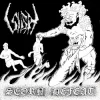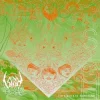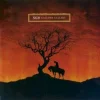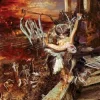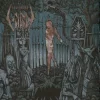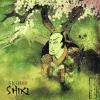History Sigh
Sigh is regarded by many as Japan's leading extreme metal export, having released numerous highly esteemed recordings throughout their twenty year existence. Although originally a black metal band, Sigh became recognizably eclectic, taking influence from Romantic era classical music, jazz, prog rock, dark electronica and more.
In May of 1990 three musicians attending the same college formed a band called Sigh. The lineup consisted of Mirai Kawashima on bass, vocals and keyboards, Satoshi Fujinami on guitar, and Kazuki Ozeki on percussion. The name Sigh felt appropriate, as a sigh can express a variety of emotions. Gathering influences from a variety of sources mainly rooted in 1980s thrash and first wave black metal, Sigh quickly shunned their earlier roots as a cover band and began to put together material for a demo to be released a month later. Desolation showed the band at its earliest, comprising of three songs that would be rerecorded later on.
Kazuki left Sigh after the completion of Desolation. His tastes differed slightly than Mirai and Satoshi, favoring bands like Blind Guardian and Paradise Lost over the rising trend of death metal. This affected his ability to play, and once he realized he could not provide the level of intensity the other members required, he willingly left the group. There were no hard feelings regarding his departure either way. To this day, Kazuki's greatest contribution to Sigh is the band's logo, which he drew.
Mirai and Satoshi worked together as a pair from then on, with the occasional guest or two assisting the band for live performances. In December of 1990 the band issued their second demo; Tragedies. The demo marked a greater point of success for the band, with all three songs (The rerecorded version of "Weakness Within" was included in the Wild Rags re-release of the demo in 1991) from the first demo rerecorded in addition to two new songs. The demo was well received, but still marked a primitive point for the band.
The Requiem for Fools EP was released in 1992 and was the first recording that the band was satisfied with. Still working together as a two piece, Sigh managed to gain the attention of Euronymous with this EP. The EP was originally sent to Dead, but wound up in the hands of Euronymous due to Dead's suicide. Being the central figure in the Norwegian Black Metal scene and mastermind behind Mayhem, the credibility of Euronymous behind Sigh meant great things were in store for the band. Mirai began trading tapes and exchanging letters with several members of the Norwegian scene, including Samoth, Garm, Faust, and Count Grishnackh, among others. This contact provided a vital influence in how Sigh presented themselves visually, who would soon dawn corpsepaint for all photos and performances.
In the summer of 1992, auditions for a new guitarist were held. Out of those who tried out, Shinichi Ishikawa was chosen. The fact that he mentioned Venom as an influence proved rare in a land where extreme metal was still in its earliest stages. His "audition" consisted of the three jamming a few Venom tracks during rehearsal. Once admitted, Satoshi focused his attention on the drums from this point to accommodate the change.
The band was soon ready to record a full-length album and Euronymous was interested in having it released on his record label, Deathlike Silence Productions. The debut album, Scorn Defeat, was recorded in March of 1993 with eight songs of early thrash and black metal influences. Euronymous was never able to release the album on his label in time, due to his murder in August that same year. Instead, the album was released on Voices of Wonder, which took over Deathlike Silence Productions after the death of Euronymous. The album was instantly a cult classic in the black metal world, which would influence the symphonic aspects of bands like Emperor and Cradle of Filth. A song from the album; "Ready for the Final War," was later chosen to represent the band on the UK black metal compilation CD Blackened.
Sigh recorded an early cut of "The Zombie Terror" in January of 1994 for a compilation album featuring many artists of the Japanese metal underground called Far East Gate In Inferno. The compilation was being put together by the band Sabbat, one of the most influential and earliest black metal bands in Asia.
In April the same year two more songs were recorded for a split seven inch EP with the Greek band Kawir. The EP was released through a new UK based label called Cacophonous Records.
A small German record label called Voices from the Dark Side Productions released a Sigh tribute to Venom cassette in October of 1994 called To Hell and Back. All tracks were taken from live performances.
Sigh entered the studio from February to June in 1995 to record Infidel Art, their second album. Three of the album's six tracks were new renditions of older material. Musically, the album relies more on the use of synthesizers than previous recordings, with several keyboard tracks playing simultaneously. The early thrash and black metal influences maintain their presence. Infidel Art was released a few months later through Cacophonous Records, who inked a four album deal with Sigh.
Recordings from Sigh's early live performances were gathered and compiled for a live CD entitled The Eastern Force of Evil: Live '92-'96. The CD features live Venom and Death covers in addition to songs from the first two albums. An early version of "Shikigami" from the upcoming release, Ghastly Funeral Theatre, was also included.
For their next recording, Sigh originally intended to release a split album with the fellow Japanese black metal group, Abigail, however Abigail's record label at that time, Modern Invasion, objected to this idea. The idea was then to release a split with the Swedish band, Vergelmar, however this also fell through. Tired of struggling to negotiate deals with bands on other labels, Ghastly Funeral Theatre was released alone as a mini-CD in 1997. The entire CD is dedicated to different aspects of Japanese occultism which Sigh had briefly addressed on the first two albums. The music on the CD is much more straightforward and shorter in comparison to the material on Infidel Art.
At the same time that Ghastly Funeral Theatre was being recorded, Sigh was also busy preparing material for the third album. An unreleased EP entitled Shadowking was recorded during this time, with the title track being an experiment with MIDI technology. Two of the three songs from these sessions were officially released on the Roots compilations, with the third being a bonus on the Psychic Scream re-release of Scorn Defeat.
Hail Horror Hail blew minds apart upon its release later in 1997. Being Sigh's third full-length, it definitely proved that the band had gone through a major progression while still retaining their roots. The album is completely structured around the premise of being a horror film without the pictures, leaving it to the imagination to define what is really taking place. Due to its unconventional sound and methods of experimentation, a warning label printed on the case explaining the nature of the CD to unsuspecting buyers. The band dropped their corpsepaint for the album, having grown tired of all the unoriginal clones that had risen. To this day, many refer to Hail Horror Hail as Sigh's masterpiece, which was supported by praises from medias like Terrorizer and Kerrang.
Sigh's deal with Cacophonous Records was beginning to present itself as an issue to the band, who was not satisfied with their performance. The label had hardly managed to promote any of the band's releases, including Hail Horror Hail, and failed to keep their promise with having the past albums released on vinyl. The fact that the label contributed no funding for touring and had bad distribution also pushed the band to its decision to seek another label. Sigh made contact with Century Media Records, who expressed interest, however Cacophonous intervened and threatened legal action until the four album contract had been fulfilled.
The band traveled to the United States to play a few east coast shows as well as a few dates in Great Britain and Ireland, before going to work on the fourth full-length release.
Scenario IV: Dread Dreams forged a different path than the previous album while still retaining an experimental quality. Following the concept of dreams, the album takes many unpredictable, questionably random turns , in order to stay true to that concept. The album was the first of Sigh's to feature a number of guest contributions, with many lyrics coming from members of other bands. The album was released in 1999 with no promotion from Cacophonous. The band also has its doubts as to whether or not the label even paid to have the album mastered.
Before 1999 was over Mirai and Shinichi got together with Yasuyuki and Youhei from Abigail and formed Cut Throat. The focus of the group was to make classic thrash covers with the occasional original composition every now and then. While existing solely for the entertainment of its members, Cut Throat still recorded and released the Rape Rape Rape album on the Root of all Evil label that same year.
Once Sigh's deal with Cacophonous Records was completed, the band immediately left the label to pursue a better deal. Eventually, the band signed with Century Media, who promised the band the treatment they had been deprived for many years. Work on the 5th full-length album commenced, with the band going into the studio in September of 2000. The album, entitled Imaginary Sonicscape, was the band's most ambitious album thus far, combining classic psychedelic elements with the metal always present in their roots. The album took many months to perfect under the direction of Yukito Okazaki from the stoner doom metal band Eternal Elysium. Finally, the album saw release in July of 2001. The album received a great deal of praise from a variety of sources upon its release.
Mirai participated in a side project with Killjoy of [artist[Necrophagia[/artist] called Enoch. A full-length entitled Graveyard Disturbances saw release in 2001; the music illustrating the two member's love for vintage horror film soundtracks. Some of the album's tracks were rearranged versions of songs written by Mirai as early as 1995 for an unreleased project called Funeral Theatre.
Sigh was also recorded a cover of John Coltrane's "Spiritual" for a tribute album scheduled for release in 2002, but never materialized. The cover is unreleased. Also, the makers of the online video game Adellion hired Mirai to score several original compositions for the game.
Century Media helped fund Sigh's first proper United States tour in April and May of 2002. Yasuyuki toured with the band, covering bass duties so that Mirai could focus on the keyboards. Khanate and Thrones were also on the same tour.
Before the tour was even over Mirai had already revealed that the writing process for the sixth full-length had begun. The album, entitled Gavotte Grim was estimated to be released in 2003.
In June of 2002 Necrophagia announced that Mirai had joined as their permanent keyboardist, which he had been keeping a secret for the last few months. He wrote a few songs for their EP Goblins be Thine and toured with the band.
A split seven inch EP with Necrophagia and Sigh was released in 2003, featuring Sigh's cover of Necrophagia's "Yong Burial." Another seven inch split EP entitled Evilized Japan was released later in 2004 with Abigail, with Sigh's side comprising of two live Venom covers. Sigh contributed a cover of Hawkwind's "Psychedelic Warlords" for a tribute CD.
Realizing that the direction of the next Sigh full-length would require more in the drum field, Junichi Harashima (藹々番地, Shady Glimpse, and formerly of Hellchild and 五人一首) was recruited, with Satoshi moving to bass. The name of the album was changed from Gavotte Grim to Gallows Gallery, and was recorded in 2004. In sound, the album was unlike anything Sigh had ever released, with Mirai's black metal rasps being discarded in favor of clear vocals. The album pays homage to 1980s heavy metal, more than anything else, while also still including a great deal of keyboards and synthesizers.
Because Century Media was disappointed that the band had not gone in a more black metal direction with the album, the band was forced to find another label to distribute Gallows Gallery. To hide this story, the band engineered a different reason as to why Century Media would not release the album: their use of sonic weapon techniques on the album. A warning was issued about the new album, saying it could do harm to one's health due to the implementation of such techniques. Mirai was apparently hospitalized while working on the album, which was one of the reasons it took the album so long to be released. This elaborate, but fictitious plot helped conceal the fact that the album was also cheaply mastered.
After several delays, the album was finally released in September of 2005 on both Candlelight and Baphomet records. The album was received well by the majority, with Terrorizer Magazine awarding it the 14th best album of 2005.
That same year Mirai was involved in new releases from the Meads of Asphodel, Necrophagia, Hidden, Hallowmass, and Cut Throat. Abigail put together a 7" EP tribute to Sigh which featured Mirai on keyboards.
Before the year was over, Mirai announced that he had formed a creative collaboration with Shane Embury of Napalm Death for a second album under the name Blood from the Soul. Due to the busy schedules of both members, there hasn't been much progress made on this project yet.
Work on a second Enoch album entitled Solamente Nero had already begun, and while Mirai's parts were completed, the album was not released due to future problems with Killjoy that ended Mirai's partnership with Killjoy and Necrophagia.
A new Cut Throat seven inch EP entitled Branded then Whipped was released in January of 2006. The writing and recording process for Sigh's seventh full-length album named Hangman's Hymn also began during this time.
Sigh then proceeded to shock fans when it was announced that the band had been signed to the United States progressive label, The End Records, which has housed renowned acts Agalloch, Dissection, Green Carnation, Unexpect and Voivod, just to name a few. Fans were also blown away when the announcement that Hangman's Hymn would be released on The End Records by the end of 2006 (But was delayed many times until a June 2007 date was secured).
Hangman's Hymn is a ten track assault of orchestrated violence, deriving heavy influence from German classical Romantic composers such as Anton Bruckner, Gustav Mahler, and Richard Wagner. It is divided into three acts, and marks the return of Mirai's harsh vocals after their absence on Gallows Gallery. The album cleverly introduces reoccurring themes which, as the album progresses, build up into one of the most climactic finales ever heard in Sigh history. Sigh went into the studio in August 2006 to record the album. It was released on June 12 on The End Records and May 23 on Soundholic Records in Japan (With bonus tracks).
2007 began as strong as ever for the band, who played their first show in over five years on March 17th at Shin-Okubo Hotspot in Tokyo. Dr. Mikannibal joined the band on stage for the first time on the alto sax and backing vocals.
Later it was announced that she would become the next official member of the band.
Nearly a month later, on April 8th, the band played at Norway's Inferno Festival. The band's performance at Inferno was eagerly anticipated and the band exceeded expectations with a set list that covered a lot of the band's early history.
A United States summer tour scheduled for June and July was abruptly cancelled due to financial issues on behalf of the End Records. The band was still scheduled to play their first ever two shows with Mayhem, however these two shows were cancelled when Hellhammer received an injury that prevented him from playing.
In November of 2007, The End Records reissued a remastered Gallows Gallery complete with bonus tracks and outtakes.
Sigh kicked off 2008 recording seven Venom covers in the studio with Dr. Mikannibal on lead vocals; an excercise likened to Metallica's initiation of Jason Newsted on the Garage Days Re-Visted EP. The final product, "A Tribute To Venom," was released on September 2nd through The End Records on black, red, and peppermint vinyl in limited quantities.
The band followed this release up with their first headlining North American tour spanning fourteen cities with Unexpect from September 6th to September 22nd. Zimmer's Hole was originally supposed to join the tour as well, though immigration issues held them back. Yasuyuki Suzuki, once again, filled the bass position for the tour.
Sigh is featured in Sam Dunn's 2008 documentary "Global Metal."
At this point in time, Sigh appears in definitive shape. Currently preparing to record their eighth full-length album, entitled "Scenes from Hell / Tempore Belli / Vanitas" which will feature session brass and string section work. But has now been officially changed to simply "Scenes From Hell". For eighteen years Sigh has represented Japan as one of their leading metal bands to emerge worldwide; gaining success and acclaim. They have opened the door for many other bands to follow, further expanding the quality of the far eastern scene. Sigh is a band who is not afraid to frequently experiment with change, traveling into a realm never before attempted. They are a band who deserve every piece of recognition that they earn, and after their history of releases... they have earned the attention of countless metal fans worldwide.
There were surely be more to write here as time passes on.
Creative Commons By-SA License
 FM
FM

